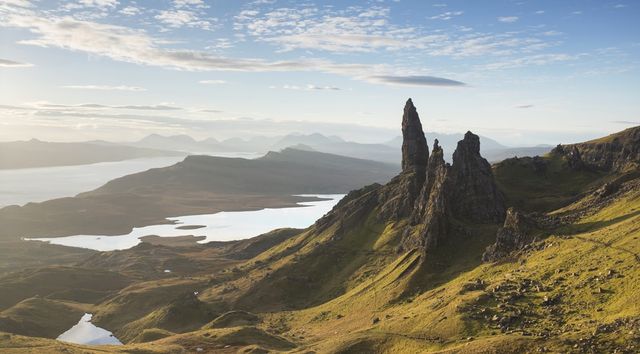3.2.3
Sediment Transportation
Longshore Drift
Longshore Drift
Longshore drift transports material along coastlines when waves approach the beach at an angle.


Swash direction
Swash direction
- Wind approaches the coast at an angle because of a prevailing wind direction.
- Waves are controlled by the wind and so this angle will be the direction the swash moves up the beach.


Backwash direction
Backwash direction
- Gravity is the only force that acts on the backwash, so it falls back to the sea at right angles to the coastline.


Overall effect
Overall effect
- Because of the difference between the angle of the swash and the angle of the backwash, sediment repeatedly moves in the shape of a right-angled triangle.
- Over time, sediment is carried along a beach.
Depositional Landforms
Depositional Landforms
Coastal landforms caused by deposition include beaches, spits, bars, tombolos and cuspate forelands.


Spits
Spits
- When the coast changes direction at an estuary (where a river meets the sea), longshore drift continues to move sediment across the inlet.
- The river doesn't let the spit completely join to the coast on the other side because the river has the energy to move the sediment.
- Spits are the long fingers of sand sticking out from one side in a coastline that have been curved by secondary winds. They often have salt marshes behind them.


Bars
Bars
- A bar is formed when a spit grows across a bay.
- Lagoons often form behind bars.


Beaches
Beaches
- Beaches are made by constructive waves moving and depositing sand or shingle inland.
- Generally, a more gently sloping beach tends to be formed from sand, whereas a steeper sloping beach is formed from pebbles.


Tombolos
Tombolos
- If a spit stretches across the mainland and joins an offshore island, this causes the formation of a tombolo.


Cuspate forelands
Cuspate forelands
- Cuspate forelands form when sediment is deposited across a bay caused by longshore drift transporting sediment in two directions.
- This leads to the formation of two spits which eventually meet and this then results in the trapping of sediment until eventually new land is formed.
The Sediment Cell Concept
The Sediment Cell Concept
The sediment cell concept describes a closed system operated by sources, transfers and sinks driven by erosion, transportation and deposition processes.


Sources
Sources
- The sources are subaerial processes, erosional processes (breaking down cliffs) and sediments brought to the coastline by rivers.
,h_400,q_80,w_640.png)
,h_400,q_80,w_640.png)
Transfers
Transfers
- Transfers are longshore drift, onshore and offshore winds and tides.
,h_400,q_80,w_640.png)
,h_400,q_80,w_640.png)
Sinks
Sinks
- The sinks are depositional landforms (spits, bars, beaches and sand dunes).


The UK
The UK
- The UK has 11 key sediment cells and sub-cells, each one with its own Shoreline Management Plan (SMP).
1Tectonic Processes & Hazards
1.1Tectonic Processes & Hazards
1.2Natural Disasters
1.3Natural Disaster Case Studies
1.4Trends & Patterns
2Option 2A: Glaciated Landscapes & Change
2.1Glaciated Landscapes Over Time
2.2Periglacial Landscapes
2.3Glacial Processes
2.4Glacial Landforms
3Option 2B: Coastal Landscapes & Change
3.1Coastal Landscapes
3.2Coastal Erosion & Deposition
3.3Coastal Risks
4Globalisation
4.1Globalisation
4.2Negatives of Globalisation
4.3Global Shift
4.5Culture
4.6Measuring Development
5Option 4A: Regenerating Places
5.1Types of Economies
5.2Function of Places
5.3Regeneration
5.4Regeneration Case Studies
6Option 4B: Diverse Places
6.1Population Structure
6.2Past & Present Connections
6.3Urban & Rural Spaces
6.4Diversity
6.5Urban & Rural Case Studies
6.6Case Study - Tower Hamlets
6.7Case Study - Sturton-le-Steeple
7The Water Cycle & Water Insecurity (A2 only)
7.1Hydrological Processes Global to Local
7.2Influences on the Water Cycle
7.3Water Insecurity
8The Carbon Cycle & Energy Security (A2 only)
8.1The Carbon Cycle
8.2Energy Consumption
8.3Alternative Energy
8.4Growing Demand for Resources
9Superpowers (A2 only)
9.1Superpowers
9.2Hard & Soft Power
9.2.1Hard & Soft Power
9.2.2Emerging Powers - China Rivalry
9.2.3Emerging Powers - Chinese Sources of Power
9.2.4Emerging Powers - Brazil
9.2.5Emerging Powers - Russia
9.2.6Emerging Powers - India
9.2.7Theories of Development
9.2.8Power Case Studies: Chinese One Belt One Road
9.2.9Power Case Studies: Pakistan Nuclear Arms
9.2.10Power Case Studies: OPEC
9.3IGOs, TNCs & Alliances
10Option 8A: Health & Human Rights (A2 only)
10.1Human Development
10.2Role of Governments & IGOs
10.3Human Rights
10.4Interventions
11Option 8B: Migration & Identity (A2 only)
11.1Globalisation & Migration
11.2Consequences of Migration
11.3Nation States
11.4Responses to Global Migration
Jump to other topics
1Tectonic Processes & Hazards
1.1Tectonic Processes & Hazards
1.2Natural Disasters
1.3Natural Disaster Case Studies
1.4Trends & Patterns
2Option 2A: Glaciated Landscapes & Change
2.1Glaciated Landscapes Over Time
2.2Periglacial Landscapes
2.3Glacial Processes
2.4Glacial Landforms
3Option 2B: Coastal Landscapes & Change
3.1Coastal Landscapes
3.2Coastal Erosion & Deposition
3.3Coastal Risks
4Globalisation
4.1Globalisation
4.2Negatives of Globalisation
4.3Global Shift
4.5Culture
4.6Measuring Development
5Option 4A: Regenerating Places
5.1Types of Economies
5.2Function of Places
5.3Regeneration
5.4Regeneration Case Studies
6Option 4B: Diverse Places
6.1Population Structure
6.2Past & Present Connections
6.3Urban & Rural Spaces
6.4Diversity
6.5Urban & Rural Case Studies
6.6Case Study - Tower Hamlets
6.7Case Study - Sturton-le-Steeple
7The Water Cycle & Water Insecurity (A2 only)
7.1Hydrological Processes Global to Local
7.2Influences on the Water Cycle
7.3Water Insecurity
8The Carbon Cycle & Energy Security (A2 only)
8.1The Carbon Cycle
8.2Energy Consumption
8.3Alternative Energy
8.4Growing Demand for Resources
9Superpowers (A2 only)
9.1Superpowers
9.2Hard & Soft Power
9.2.1Hard & Soft Power
9.2.2Emerging Powers - China Rivalry
9.2.3Emerging Powers - Chinese Sources of Power
9.2.4Emerging Powers - Brazil
9.2.5Emerging Powers - Russia
9.2.6Emerging Powers - India
9.2.7Theories of Development
9.2.8Power Case Studies: Chinese One Belt One Road
9.2.9Power Case Studies: Pakistan Nuclear Arms
9.2.10Power Case Studies: OPEC
9.3IGOs, TNCs & Alliances
10Option 8A: Health & Human Rights (A2 only)
10.1Human Development
10.2Role of Governments & IGOs
10.3Human Rights
10.4Interventions
11Option 8B: Migration & Identity (A2 only)
11.1Globalisation & Migration
11.2Consequences of Migration
11.3Nation States
11.4Responses to Global Migration
Unlock your full potential with Seneca Premium
Unlimited access to 10,000+ open-ended exam questions
Mini-mock exams based on your study history
Unlock 800+ premium courses & e-books